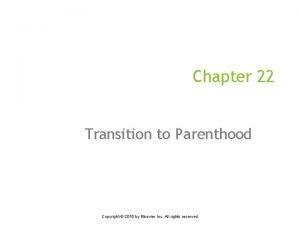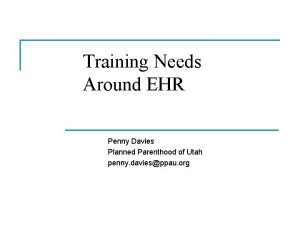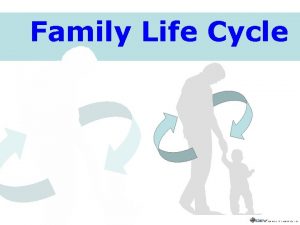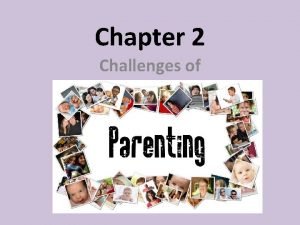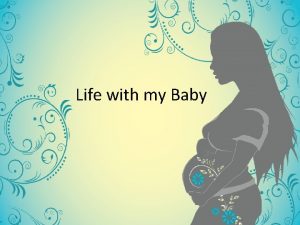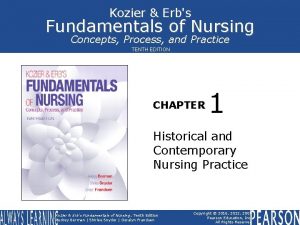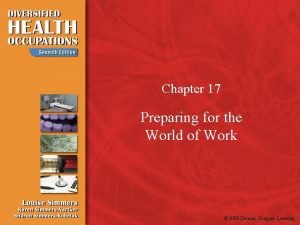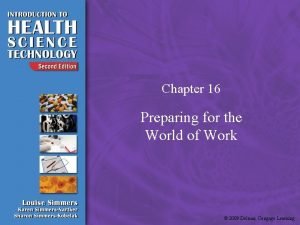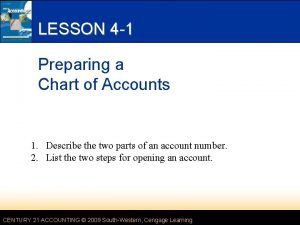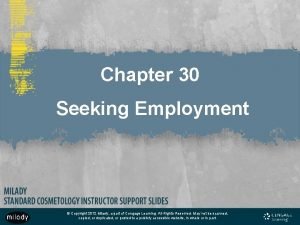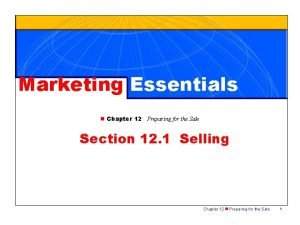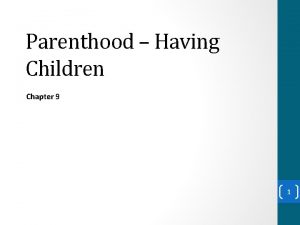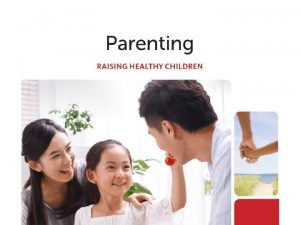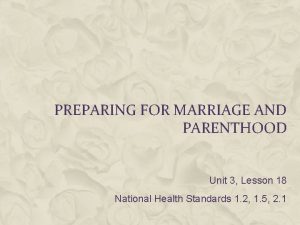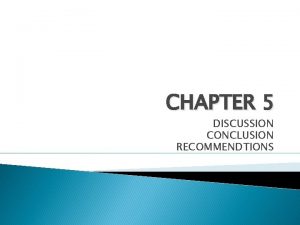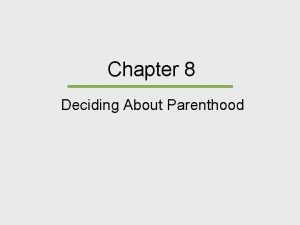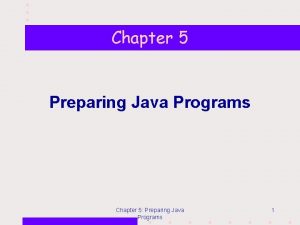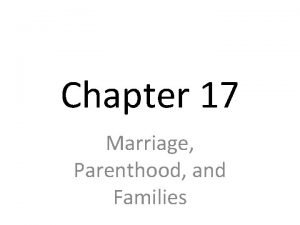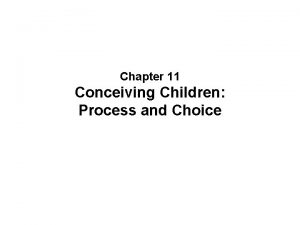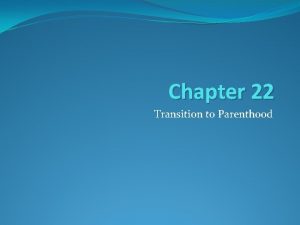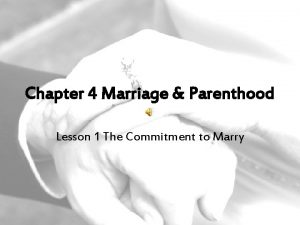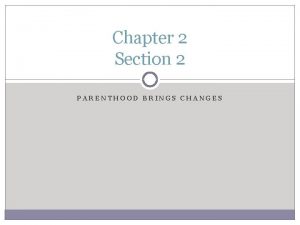Chapter 4 Preparing for Parenthood 1 Discussion 1































































- Slides: 63

Chapter 4 Preparing for Parenthood 1

Discussion 1. If you were asked to explain why you want to have children, what would you say? 2. What sort of person do you think makes a good parent? A bad parent? 3. Hypothetically, do you think there is a need in our society to require parents to earn a parenting license before having a child? Do you think you would pass the test? 4. How might a person’s own youth be a factor to consider before giving him or her a parenting license? 5. What other factors would you consider if you were issuing the licenses? 4

Choosing Whether or Not to Parent • First, the decision to parent is a permanent choice. Once a parent always a parent. • Second, a decision not to parent is not permanent. • There are 15 safe years for childbearing between 2035 years of age. 5

Reasons for Choosing Parenthood • We want to share our love and time with a child. • Wouldn’t it be nice to have a cute little baby? • Our parents want grandchildren. • Our child needs a sibling. • A child can make us proud. • A child will comfort us in our old age. • A child will make us love each other. 6

Reasons for NOT Choosing Parenthood • • • We’re not ready for a child. A baby cost a lot. A child will tie us down. A child will interfere with our careers. Our child could be sick or have a disability. Our marriage could fail, and I don’t want to be a single parent. 7

Aspects of Parenting • Parenting is a rewarding and difficult task. Many people invest more money, time and emotions in their children than they do in any investment in their life. • Most parents hope their kids have opportunities they did not have. • Before having a child a couple MUST SERIOUSLY consider and discuss all aspects of parenting. 8

Aspects of Parenting • The birth or adoption of a child instantly makes you a parent. • Parenting skills are not automatic. A person may be able to biologically reproduce, but that does not necessarily mean he or she will be a good parent. 9

Aspect: Maturity • Regardless of age, a person who may be biologically capable of conceiving a child may not have the maturity to become a parent. • There is a special type of maturity needed for parenting. • Erikson felt that teen and young adults are not best suited for parenting. – Teens need to explore their sense of independence and develop a sense of self. – Young adults need time to find out what is important to them and what sort of person they want to be before entering into a truly committed relationship. 10

Aspect: Relationships • Children are born into a network of people and relationships. • Children affect these relationships and these relationships affect children. • True parenting is not a “self-centered” activity 11

Children Affect Relationships Affect Children • Couples need to know how children will change their lives. • Couples can look at their relationship by asking questions about there feelings for others. • Children usually do you strengthen a weak marriage. • Good relationship with other e are positive for the • If a couple has good couple and their possible relationships both inside children. and outside their marriage, then having a child will • Think about how their enrich their lives. relationships with others can affect their children. 12

Aspect: Management of Resources Time and Energy Home Care • Home is where you prepare • Consider current and meals/eat, sleep, groom, future demands on time. • Parenting is the most energy-depleting role a person will likely encounter. and store many personal items. • Family and friends gather in the home. • Consider how you share tasks and how you feel • Without energy, parents about this division of duties. cannot effectively take care of their children. 13

Finances • Couples must realize children cost a lot. From birth to 17 years there are over $245, 000 worth of expenses. • The first year of childrearing is expensive and expenses grow as the child grows. Some expenses include food, clothing, housing, child care, education, transportation, toys, entertainment, and sports lessons. • Carefully planning financial resources is important for everyone. Financial planning become more important when couples think about children. 14

Other Resources Couples may want to consider: – Child care – Education programs – Schools – Park and recreation services – Health and medical services – Youth organizations – Community programs – Religious groups 15

Parenting Roles, Responsibilities, and Styles 16

Parenting Roles and Responsibilities • Children thrive in a nurturing environment. • They learn to become responsible members of a community through socialization by their parents and other members of their family. 19

Parents Roles & Responsibilities: Nurturance • Nurturance includes: emotional and physical nourishment and care given to someone. -physical aspects of child care, • feeding, dressing, and bathing children -intellectual needs stimulating environment -social-emotional needs helping children feel secure and loved 20

Parents Roles & Responsibilities: Socialization • People are born into a community. • Children need to form strong relationships with their parents. • Children need a sense of belonging. • Parents teach children about the way of life within in the group. • Each social group may have it’s own language, beliefs, attitudes, values, rituals and skills. 21

Another name for a social group is culture. • Using the aspects (parts) of a person’s culture to socialize is called enculturation. • Children learn most of their culture values at home. • Parents also teach their children how to respond in a culturally diverse society. • Parents who do not value diversity often believe their group is better than others and that people of different group should not interact with one another. 22

Parents Roles & Responsibilities Guidance & Discipline • Guidance includes the words and actions parents use to influence their children’s behavior. • Discipline is the use of methods and techniques to teach children self-control. Through discipline, children learn to act in a way that society finds acceptable. • Punishment is a consequence for a misdeed. 23

• One major goal of guidance and discipline is to build character in children. • Character is the principles and beliefs that guide a person’s conduct (actions and manners) and define his or her personality and behavior. • Some forms of discipline are better than others. • Types of discipline (power assertion, love withdrawal, and induction). 24

Power Assertion Power assertion occurs when parents use or threaten to use some form of physical punishment or deny privileges. 25

Love Withdrawal Parents threaten children with being unloved or suggest some form of parent/child separation. • Examples: – Tell them you will give them away. – Silent treatment. 26

Induction, parents discipline their children by reasoning and explaining to them why they should or should not use certain behaviors. 27

Parenting Styles The parents own childhood experience, beliefs, and temperament, as well as the temperament of the child influence parenting style. 28

Authoritarian Parenting style, in which the main objective is to make children completely obedient. They expect children to represent their authority with little or no explanation as to why children should obey. Results of the Style • • • Moody Unhappy Aggressive Not friendly Vulnerable to stress Trouble getting along with those in authority. 29

Permissive Give children almost no guidelines or rules. They feel children should make their own decision about right and wrong. • Some permissive parents are also overindulgent (provide everything the child wants). • These children may feel lost. Results of the Style • • • Not self-centered Not self-reliant Impulsive Aggressive rebellious Low Achievement 30

Over-parenting • Over-parenting can be defined as parenting by controlling every move of the child. Begins in infancy. • These children may be more self-centered & have a sense of self entitlement (right to particular privileges or benefits). Results of the Style – Doing child’s homework/projects – Resolving conflicts with adults and peers w/o allowing children to try to resolve conflicts. – Discouraging independent exploration. – Attending job interviews with their child. – Kids often do not achieve. – May stay dependent on parents even as adults (Boomerang Generation-some may move back with parents as adults for parental services) 31

Authoritative Parents set rules but allow children some freedom. Parenting experts endorse this style. These parents also use the induction method of discipline. Long term results for children are most positive. These children learn self-discipline in a positive, encouraging setting. 32

Family Planning Family planning involves decisions couples make about whether or not they want to have children and when to have them. It is a couple’s personal choice. 34

Family Planning – Birth control methods measures couples use to help prevent pregnancy. Couples may want to ask their doctor. – Birth control will impact your current health. – Pre-pregnancy preparation (weight, nutrition, vitamins, lifestyle) can affect the outcome – Spacing pregnancy (18 -23 months) after delivery to become pregnant again is important to the health of both mom and fetus/child. 35

• A spacing of about 3 years is advised for developmental reasons. • Ample (generous amount) spacing gives parents time to work with each child alone before they need to divide their attention. • Ample spacing allows the family to establish routines and roles. • Less jealousy between children occurs when there is a 3 -year age difference. 36

Key Terms • Female System: Vagina, Uterus, Fallopian Tubes, Ovaries • Abstinence • Natural Family Planning • Barrier Methods • Hormonal methods • Implantable methods • Permanent - Surgical methods 37

Birth Control Methods

39

40

Female Anatomy - Size of Parts Uterus – the size of your fist Ovary – the size of a cotton ball Fallopian tube – the size of a Capri Sun straw cut in ½ Vagina - 3 to 5 inches in length Cervix – the top of your closed fist 41

Continuous Abstinence Not having sexual intercourse at any time. It is the only sure way to prevent pregnancy and protect against sexually transmitted infections (STIs), including HIV.

Rhythm Method • You have to learn about your cycle by keeping a written record of: – The first day of your period, how long it lasts – What it is like…heavy or light blood flow. – How you feel…sore breasts, cramps. • Keeping track of your cervical mucus and body temperature. Most fertile when mucus is clear and looks like egg whites. • A woman who has a regular menstrual cycle has about 9 or more days each month when she is able to get pregnant. These fertile days are about 5 days before and 3 days after ovulation, as well as the day of ovulation.

Barrier Methods of Birth Control Block the sperm from getting to the egg • Sponge • Cervical cap • Female condom • Male condom 44

Barrier Method: Sponge • This barrier method is a soft, disk-shaped device with a loop for taking it out. It is made out of polyurethane foam and contains the spermicide nonoxynol-9. Spermicide kills sperm. • The sponge is effective for more than one act of intercourse for up to 24 hours. It needs to be left in for at least 6 hours after having sex to prevent pregnancy. It must then be taken out within 30 hours after it is inserted. • Only one kind of contraceptive sponge is sold in the United States. It is called the Today Sponge. Women who are sensitive to the spermicide nonoxynol-9 should not use the sponge. 45

Barrier Method: Diaphragm, Cervical Cap, and Cervical Shield Diaphragm Cervical Cap • The diaphragm is a shallow latex cup that comes in different sizes and you need a doctor to fit you for one. The diaphragm should be taken out within 24 hours. • The cervical cap is a thimbleshaped latex cup. It often is called by its brand name, Fem. Cap. • Comes in different sizes and you need a doctor to fit you for one. Should be taken out within 48 hours. 46

• The cervical shield is a silicone cup that has a one-way valve that creates suction and helps it fit against the cervix. It often is called by its brand name, Lea’s Shield. The cervical shield comes in one size, and you will not need a fitting. Should be taken out within 48 hours. • All three of these barrier methods must be left in place for 6 to 8 hours after intercourse to prevent pregnancy. 47

Barrier Method: Female Condom • This condom is worn by the woman inside her vagina. It keeps sperm from getting into her body. • It is made of thin, flexible, manmade rubber and is packaged with a lubricant. • It can be inserted up to 8 hours before having sex. • Use a new condom each time you have intercourse. • Don’t use it and a male condom at the same time. 48

Barrier Method: Male Condom • Male condoms are a thin sheath placed over an erect penis to keep sperm from entering a woman’s body. • Condoms can be made of latex, polyurethane, or “natural/lambskin”. The natural kind do not protect against STIs. • Condoms work best when used with a vaginal spermicide, which kills the sperm. And you need to use a new condom with each sex act. • Condoms are either {Lubricated and Non-lubricated} • Keep condoms in a cool, dry place. If you keep them in a hot place (like a wallet or glove compartment), the latex breaks down. Then the condom can tear or break. 49

Hormonal methods Interferes with ovulation, fertilization or implantation

Hormonal Method: The Pill • The pill contains the hormones estrogen and progestin. • It is taken daily to keep the ovaries from releasing an egg. • The pill also causes changes in the lining of the uterus and the cervical mucus to keep the sperm from joining the egg. • Some women prefer the “extended cycle” pills. These have 12 weeks of pills that contain hormones (active) and 1 week of pills that don’t contain hormones (inactive). While taking extended cycle pills, women only have their period three to four times a year. 51

Hormonal Method: The Pill Your doctor may advise you not to take the pill if you: – Are older than 35 and smoke – Have a history of blood clots – Have a history of breast, liver, or endometrial cancer • Antibiotics may reduce how well the pill works in some women. • Talk to your doctor about a backup method of birth control if you need to take antibiotics. • Many types of oral contraceptives are available. Talk with your doctor about which is best for you. 52

Hormonal Methods: The Patch • Also called by its brand name, Ortho Evra, this skin patch is worn on the lower abdomen, buttocks, outer arm, or upper body. • It releases the hormones progestin and estrogen into the bloodstream to stop the ovaries from releasing eggs in most women. It also thickens the cervical mucus, which keeps the sperm from joining with the egg. • You put on a new patch once a week for 3 weeks. You don’t use a patch the fourth week in order to have a period. 53

Hormonal Method: The Shot • The birth control shot often is called by its brand name Depo-Provera. • With this method you get injections, or shots, of the hormone progestin in the buttocks or arm every 3 months. • A new type is injected under the skin. The birth control shot stops the ovaries from releasing an egg in most women. It also causes changes in the cervix that keep the sperm from joining with the egg. 54

Hormonal Method: The Shot • The shot should not be used more than 2 years in a row because it can cause a temporary loss of bone density. • The loss increases the longer this method is used. The bone does start to grow after this method is stopped. But it may increase the risk of fracture and osteoporosis if used for a long time. 55

Hormonal Method: Vaginal Ring • This is a thin, flexible ring that releases the hormones progestin and estrogen. • It works by stopping the ovaries from releasing eggs. It also thickens the cervical mucus, which keeps the sperm from joining the egg. • It is commonly called Nuva. Ring, its brand name. You squeeze the ring between your thumb and index finger and insert it into your vagina. • You wear the ring for 3 weeks, take it out for the week that you have your period, and then put in a new ring. 56

IMPLANTABLE DEVICES Implanted into the body and left for a few years. 57

Implantable Devices: Implantable Rod • This is a matchstick-size, flexible rod that is put under the skin of the upper arm, effective up to 5 years. • It is often called by its brand name, Implanon. • The rod releases a progestin, which causes changes in the lining of the uterus and the cervical mucus to keep the sperm from joining an egg. 58

Implantable Devices: IUD • An IUD is a small device shaped like a “T” that goes in your uterus. There are two types: Copper IUD • — The copper IUD goes by the brand name Para. Gard. It releases a small amount of copper into the uterus, which prevents the sperm from reaching and fertilizing the egg. It fertilization does occur, the IUD keeps the fertilized egg from implanting in the lining of the uterus. A doctor needs to put in your copper IUD. It can stay in your uterus for 5 to 10 years. 59

Hormonal IUD • — The hormonal IUD goes by the brand name Mirena. It is sometimes called an intrauterine system, or IUS. It releases progestin into the uterus, which keeps the ovaries from releasing an egg and causes the cervical mucus to thicken so sperm can’t reach the egg. It also affects the ability of a fertilized egg to successfully implant in the uterus. A doctor needs to put in a hormonal IUD. It can stay in your uterus for up to 5 years. 60

Permanent Methods • To ensure that a person never has a child or doesn’t want anymore children. • Examples: Sterilization implant, Surgical sterilization

Sterilization Implant • Sterilization Implant is the first nonsurgical method of sterilizing women. • A thin tube is used to thread a tiny spring-like device through the vagina and uterus into each fallopian tube. • The device works by causing scar tissue to form around the coil. This blocks the fallopian tubes and stops the egg and sperm from joining. • It can take about 3 months for the scar tissue to grow, so it’s important to use another form of birth control during this time. • Then you will have to return to your doctor for a test to see if scar tissue has fully blocked your tubes. 62

Surgical Sterilization For women, surgical sterilization closes the fallopian tubes by being cut, tied, or sealed. This stops the eggs from going down to the uterus where they can be fertilized. The surgery can be done a number of ways. Sometimes, a woman having cesarean birth has the procedure done at the same time, so as to avoid having additional surgery later. For men, having a vasectomy (vuh-SEK-tuh-mee) keeps sperm from going to his penis, so his ejaculate never has any sperm in it. Sperm stays in the system after surgery for about 3 months. During that time, use a backup form of birth control to prevent pregnancy. A simple test can be done to check if all the sperm is gone; it is called a semen analysis. 63

Female Sterilization

Male Sterilization-Vasectomy

Emergency Contraceptives • Used when the females primary birth control fails. • Should never be used as a primary form of birth control!!! • Examples: Plan B, One Step, Morning After Pill

Works Cited: • www. womenshealth. gov • U. S. Department of Health and Human Services, Office on Women’s Health • Pictures from google

The End 68
 Chapter 22 transition to parenthood
Chapter 22 transition to parenthood Ppau [email protected]
Ppau [email protected] 5 stages of family life cycle
5 stages of family life cycle Medfusion planned parenthood
Medfusion planned parenthood Galinsky's stages of parenthood
Galinsky's stages of parenthood The parenthood decision
The parenthood decision The parenthood decision
The parenthood decision Safe sleep seven
Safe sleep seven Shea maloney
Shea maloney Planned parenthood is done margaret sanger
Planned parenthood is done margaret sanger Aim of simple distillation
Aim of simple distillation 18:1 preparing for the world of work
18:1 preparing for the world of work Chapter 17:3 completing job application forms
Chapter 17:3 completing job application forms Chapter 18 preparing for the world of work
Chapter 18 preparing for the world of work Chapter 15 preparing for careers
Chapter 15 preparing for careers Preparing a chart of accounts
Preparing a chart of accounts Chapter 1 preparing your path to success
Chapter 1 preparing your path to success Milady chapter 30 test
Milady chapter 30 test Chapter 12 preparing for the sale
Chapter 12 preparing for the sale Kontinuitetshantering i praktiken
Kontinuitetshantering i praktiken Novell typiska drag
Novell typiska drag Tack för att ni lyssnade bild
Tack för att ni lyssnade bild Vad står k.r.å.k.a.n för
Vad står k.r.å.k.a.n för Varför kallas perioden 1918-1939 för mellankrigstiden?
Varför kallas perioden 1918-1939 för mellankrigstiden? En lathund för arbete med kontinuitetshantering
En lathund för arbete med kontinuitetshantering Kassaregister ideell förening
Kassaregister ideell förening Personlig tidbok
Personlig tidbok Anatomi organ reproduksi
Anatomi organ reproduksi Vad är densitet
Vad är densitet Datorkunskap för nybörjare
Datorkunskap för nybörjare Stig kerman
Stig kerman Att skriva debattartikel
Att skriva debattartikel För och nackdelar med firo
För och nackdelar med firo Nyckelkompetenser för livslångt lärande
Nyckelkompetenser för livslångt lärande Påbyggnader för flakfordon
Påbyggnader för flakfordon Arkimedes princip formel
Arkimedes princip formel Offentlig förvaltning
Offentlig förvaltning I gullregnens månad
I gullregnens månad Presentera för publik crossboss
Presentera för publik crossboss Jiddisch
Jiddisch Vem räknas som jude
Vem räknas som jude Klassificeringsstruktur för kommunala verksamheter
Klassificeringsstruktur för kommunala verksamheter Mjälthilus
Mjälthilus Claes martinsson
Claes martinsson Cks
Cks Byggprocessen steg för steg
Byggprocessen steg för steg Mat för unga idrottare
Mat för unga idrottare Verktyg för automatisering av utbetalningar
Verktyg för automatisering av utbetalningar Rutin för avvikelsehantering
Rutin för avvikelsehantering Smärtskolan kunskap för livet
Smärtskolan kunskap för livet Ministerstyre för och nackdelar
Ministerstyre för och nackdelar Tack för att ni har lyssnat
Tack för att ni har lyssnat Referatmarkeringar
Referatmarkeringar Redogör för vad psykologi är
Redogör för vad psykologi är Borstål, egenskaper
Borstål, egenskaper Tack för att ni har lyssnat
Tack för att ni har lyssnat Borra hål för knoppar
Borra hål för knoppar Orubbliga rättigheter
Orubbliga rättigheter Formula varians
Formula varians Tack för att ni har lyssnat
Tack för att ni har lyssnat Rita perspektiv
Rita perspektiv Ledningssystem för verksamhetsinformation
Ledningssystem för verksamhetsinformation Tobinskatten för och nackdelar
Tobinskatten för och nackdelar Toppslätskivling effekt
Toppslätskivling effekt
